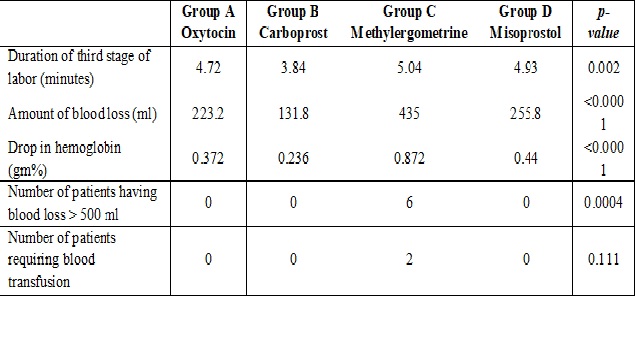A comparative study of oxytocin, carboprost, methylergometrine and misoprostol in prevention of postpartum haemorrhage a prospective study
Abstract
Background: Post partumhemorrhage (PPH) is an important cause of maternal mortality accounting for nearly 15-20% of maternal deaths in India. Oxytocic drugs like oxytocin, ergot alkaloids, and various prostaglandins are being used for active management of third stage of labour.
Materials and Methods: A prospective study was conducted in the Department of Obstetrics and Gynaecology of Al Ameen Medical College, Vijayapur, in 400 women. Patients were randomized into four groups of 100 each and were given oxytocic within 60 seconds of delivery anterior shoulder of the baby. Oxytocics used were 10 IU intramuscular oxytocin,125 µg intramuscular carboprost, 0.2 mg intravenous methylergometrine, and 800 µg tablet misoprostol per rectally in groups A, B, C and D respectively.
Results: Duration of third stage of labor recorded was minimum with carboprost with mean duration of 3.84+/-0.99 minutes and was maximum with methylergometrine with mean duration of 5.04+/-1.02 minutes. Amount of blood loss observed was minimum with carboprost (mean 131 +/-72.037 ml) and maximum with Methylergometrine (mean 435+/-147.578 ml). Hemoglobin drop was also seen more with Methylergometrine with mean drop of 0.872+/-0.458 gm% and minimally with carboprost with mean drop of 0.236 +/-0.221 gm%.
Conclusion: It is concluded from this study that carboprost is the uterotonic of choice followed by oxytocin for active management of third stage of labor.
Downloads
References
2. Christopher B. Lynch, Moore Keith. A textbook of postpartum hemorrhage, a comprehensive guide to evaluate management and surgical intervention. FOGSI publication 2006; 8.
3. Park K. Preventive medicine in obstetrics, pediatrics and geriatrics, chapter 9 in textbook of preventive and social medicine, 22ndedition. Jabalpur, M/S Banarri Das Bharot, 2013; 516-519.
4. Bhattacharya P, Devi PK, Jain S. Prophylactic use of 15 methyl PGF2α by intramuscular route for control of post partum bleeding - A comparative trial with methylergometrine. Acta Obstet Gynecol Scand Suppl1988; 145:13-5.[pubmed]
5. Prendiville WJ1, Elbourne D, McDonald S. Active versus expectant management in the third stage of labour. Cochrane Database Syst Rev. 2000;(3):CD000007. DOI:10.1002/14651858.CD000007.[pubmed]
6. Schuurmans N. Prevention and management of postpartum hemorrhage. J Soc Obstet Gynecol Can 2000; 22(4):271-281.
7. WHO department of making pregnancy safer 2009. WHO recommendations for treatment of PPH and retained placenta. WHO: Geneva. 2013. available from www.who.int.
8. Chelmow D. Postpartum hemorrhage prevention: clinical evidence. BMJ 2011; 1- 6.[pubmed]
9. Hofmeyr GJ, Gulmezoglu AM. New Development in the management of postpartum hemorrhageIn: Bonner. 21st edn. London. Churchill Livingstone. J. Recent Advances in Obstetrics & Gynaecology. 2000; 56-66.
10. FIGO. International confederation of midwives, international federation of gynecology and obstetrics (FIGO) 2006. Prevention and treatment of PPH, new advances for low resource settings. joint statement. ICM: The Hague :IFIGO:London2006.
11. Patel A, Goudar SS, Geller SE, et al. Drape estimation vs. visual assessment for estimating postpartum hemorrhage. Int J Gynaecol Obstet. 2006 Jun;93(3):220-4. Epub 2006 Apr 12. DOI:10.1016/j.ijgo.2006.02.014.[pubmeed]
12. Kamala Jayaram V, Devi ED. Prophylactic PGF2α for control of postpartum bleeding a comparative study with methyl ergometrine. J Obstet Gynaecol Ind 1994; 44:393-97.
13. Anjaneyulu R, Pk D, Jain S, et al. Prophylactic use of 15(s)15 methyl pgf2α , by intramuscular route - a controlled clinical trial. Acta ObstetGynecol Scand. 1988 Jan;67(S145):9-11. doi: 10.1111/aogs.1988.67.s145.9.[pubmed]
14. Leduc D, Senikas V, Lalonde AB; et al. Active management of the third stage of labour: prevention and treatment of postpartum hemorrhage. J ObstetGynaecol Can. 2009 Oct;31(10):980-993. doi: 10.1016/S1701-2163(16)34329-8.
15. Leung SW, Ng PS, Wong WY, et al. A randomised trial of carbetocin versus syntometrine in the management of the third stage of labour. BJOG. 2006 Dec;113(12):1459-64. DOI:10.1111/j.1471-0528.2006.01105.x
16. Pk D, Ud S, Ks R. Prophylactic use of 15(s)15 methyl pgf2α for control of postpartum bleeding. Acta ObstetGynecol Scand. 1988 Jan;67(S145):7-8. doi: 10.1111/aogs.1988.67.s145.7.[pubmed]
17. Abdel-Aleem H, Abol-Oyoun EM, Moustafa SA, et al. Carboprost trometamol in the management of the third stage of labor. Int J Gynaecol Obstet. 1993 Sep;42(3):247-50.[pubmed]
18. Kushtagi P, Verghese LM. Evaluation of two uterotonic medications for the management of the third stage of labor. Int J Gynaecol Obstet. 2006 Jul;94(1):47-8. Epub 2006 Jun 8. DOI:10.1016/j.ijgo.2006.04.011.
19. Raju B, Purushotta, Patil R. 15 Methyl PGF2 alpha and ergometrine for prevention of atonic PPH in high risk women. J Obstet Gynecol India 2008; 58(5):417-420
20. Singh G, Radhakrishnan G, Guleria K. Comparison of sublingual misoprostol, intravenous oxytocin, and intravenous methylergometrine in active management of the third stage of labor. Int J Gynaecol Obstet. 2009 Nov;107(2):130-4. doi: 10.1016/j.ijgo.2009.06.007. Epub 2009 Jul 22.[pubmed]
21. Gohil JT, Tripathi B. A Study to Compare the Efficacy of Misoprostol, Oxytocin, Methyl-ergometrine and Ergometrine-Oxytocin in Reducing Blood Loss in Active Management of 3rd Stage of Labor. J ObstetGynaecol India. 2011 Aug;61(4):408-12. doi: 10.1007/s13224-011-0060-5. Epub 2011 Sep 23.[pubmed]
22. TriptiN, Balram S. 400 µg oral Misoprostol versus 0.2 mg intravenous Methyl ergometrine for the active management of third stage of labor. JOGI2009 May/June;59(3):228-234.
23. Sorbe B. Active pharmacologic management of the third stage of labor. A comparison of oxytocin and ergometrine. Obstet Gynecol. 1978 Dec;52(6):694-7.[pubmed]
24. Amant F, Spitz B, Timmerman D, et al. Misoprostol compared with methylergometrine for the prevention of postpartum haemorrhage: a double-blind randomised trial. Br J Obstet Gynaecol. 1999 Oct;106(10):1066-70.[pubmed]
25. Chua S, Chew SL, Yeoh CL, Roy AC, Ho LM, Selamat N, Arulkumaran S, Ratnam SS. A randomized controlled study of prostaglandin 15-methyl F2 alpha compared with syntometrine for prophylactic use in third stage of labor. AustNZJObstetGynaecol1995Nov;35(4):413-416.

Copyright (c) 2019 Author (s). Published by Siddharth Health Research and Social Welfare Society

This work is licensed under a Creative Commons Attribution 4.0 International License.


 OAI - Open Archives Initiative
OAI - Open Archives Initiative



















 Therapoid
Therapoid

